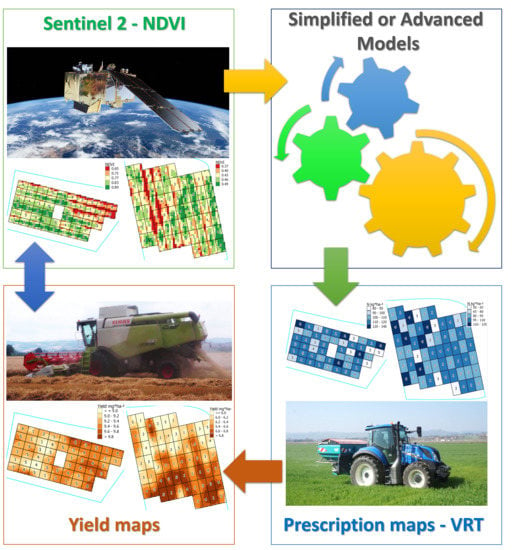Simplified and Advanced Sentinel-2-Based Precision Nitrogen Management of Wheat
Abstract
:1. Introduction
2. Materials and Methods
2.1. Study Areas and Crop Management
2.2. Soil Data
2.3. Weather
2.4. VRT Fertilization Models, Rate Calculation, and Experimental Design
2.5. NDVI Seasonal Trend
2.6. Grain Yield
2.7. Protein Content
2.8. Statistical Analysis
3. Results
Correlation Analysis between NDVI, Yield, and Soil Data
4. Discussion
5. Conclusions
Author Contributions
Funding
Institutional Review Board Statement
Informed Consent Statement
Data Availability Statement
Acknowledgments
Conflicts of Interest
References
- Aydinalp, C.; Cresser, M.S. The Effects of Global Climate Change on Agriculture. Am. J. Agric. Environ. Sci. 2008, 3, 672–676. [Google Scholar]
- Odegard, I.; Van Der Voet, E. The future of food—Scenarios and the effect on natural resource use in agriculture in 2050. Ecol. Econ. 2014, 97, 51–59. [Google Scholar] [CrossRef]
- Pierce, F.J.; Nowak, P. Aspects of Precision Agriculture. Adv. Agron. 1999, 67, 1–85. [Google Scholar] [CrossRef]
- Zheng, Q.; Huang, W.; Cui, X.; Shi, Y.; Liu, L. New Spectral Index for Detecting Wheat Yellow Rust Using Sentinel-2 Multispectral Imagery. Sensors 2018, 18, 868. [Google Scholar] [CrossRef] [PubMed] [Green Version]
- Drusch, M.; Del Bello, U.; Carlier, S.; Colin, O.; Fernandez, V.; Gascon, F.; Hoersch, B.; Isola, C.; Laberinti, P.; Martimort, P.; et al. Sentinel-2: ESA’s Optical High-Resolution Mission for GMES Operational Services. Remote Sens. Environ. 2012, 120, 25–36. [Google Scholar] [CrossRef]
- Segarra, J.; Buchaillot, M.L.; Araus, J.L.; Kefauver, S.C. Remote sensing for precision agriculture: Sentinel-2 improved features and applications. Agronomy 2020, 10, 641. [Google Scholar] [CrossRef]
- Delloye, C.; Weiss, M.; Defourny, P. Retrieval of the canopy chlorophyll content from Sentinel-2 spectral bands to estimate nitrogen uptake in intensive winter wheat cropping systems. Remote Sens. Environ. 2018, 216, 245–261. [Google Scholar] [CrossRef]
- Copernicus Open Access Hub. Available online: https://scihub.copernicus.eu/ (accessed on 28 May 2021).
- Clevers, J.G.P.W.; Kooistra, L.; van den Brande, M.M.M. Using Sentinel-2 data for retrieving LAI and leaf and canopy chlorophyll content of a potato crop. Remote Sens. 2017, 9, 405. [Google Scholar] [CrossRef] [Green Version]
- Silleos, N.G.; Alexandridis, T.; Gitas, I.Z.; Perakis, K. Vegetation Indices: Advances Made in Biomass Estimation and Vegetation Monitoring in the Last 30 Years. Geocarto Int. 2006, 21, 21–28. [Google Scholar] [CrossRef]
- Xue, J.; Su, B. Significant Remote Sensing Vegetation Indices: A Review of Developments and Applications. J. Sens. 2017, 2017, 1–17. [Google Scholar] [CrossRef] [Green Version]
- Messina, G.; Peña, J.; Vizzari, M.; Modica, G. A Comparison of UAV and Satellites Multispectral Imagery in Monitoring Onion Crop. An Application in the ‘Cipolla Rossa di Tropea’ (Italy). Remote Sens. 2020, 12, 3424. [Google Scholar] [CrossRef]
- Tassi, A.; Vizzari, M. Object-Oriented LULC Classification in Google Earth Learning Algorithms. Remote Sens. 2020, 2020, 3776. [Google Scholar] [CrossRef]
- Rouse, J.W.; Hass, R.H.; Schell, J.A.; Deering, D.W. Monitoring vegetation systems in the great plains with ERTS. In Proceedings of the 3rd ERTS Symposium, NASA SP-351, Washington, DC, USA, 10–14 December 1973. [Google Scholar]
- Muñoz-Huerta, R.F.; Guevara-Gonzalez, R.G.; Contreras-Medina, L.M.; Torres-Pacheco, I.; Prado-Olivarez, J.; Ocampo-Velazquez, R.V. A Review of Methods for Sensing the Nitrogen Status in Plants: Advantages, Disadvantages and Recent Advances. Sensors 2013, 13, 10823–10843. [Google Scholar] [CrossRef]
- Cabrera-Bosquet, L.; Molero, G.; Stellacci, A.; Bort, J.; Nogués, S.; Araus, J. NDVI as a potential tool for predicting biomass, plant nitrogen content and growth in wheat genotypes subjected to different water and nitrogen conditions. Cereal Res. Commun. 2011, 39, 147–159. [Google Scholar] [CrossRef]
- Carlson, T.N.; Ripley, D.A. On the relation between NDVI, fractional vegetation cover, and leaf area index. Remote Sens. Environ. 1997, 62, 241–252. [Google Scholar] [CrossRef]
- Stamatiadis, S.; Christofides, C.; Tsadilas, C.; Samaras, V.; Schepers, J.S.; Francis, D. Ground-Sensor Soil Reflectance as Related to Soil Properties and Crop Response in a Cotton Field. Precis. Agric. 2005, 6, 399–411. [Google Scholar] [CrossRef]
- Hansen, P.; Schjoerring, J. Reflectance measurement of canopy biomass and nitrogen status in wheat crops using normalized difference vegetation indices and partial least squares regression. Remote Sens. Environ. 2003, 86, 542–553. [Google Scholar] [CrossRef]
- Magney, T.; Eitel, J.U.; Huggins, D.R.; Vierling, L.A. Proximal NDVI derived phenology improves in-season predictions of wheat quantity and quality. Agric. For. Meteorol. 2016, 217, 46–60. [Google Scholar] [CrossRef]
- Herrmann, I.; Pimstein, A.; Karnieli, A.; Cohen, Y.; Alchanatis, V.; Bonfil, D. LAI assessment of wheat and potato crops by VENμS and Sentinel-2 bands. Remote Sens. Environ. 2011, 115, 2141–2151. [Google Scholar] [CrossRef]
- Sultana, S.R.; Ali, A.; Ahmad, A.; Mubeen, M.; Zia-Ul-Haq, M.; Ahmad, S.; Ercisli, S.; Jaafar, H.Z.E. Normalized Difference Vegetation Index as a Tool for Wheat Yield Estimation: A Case Study from Faisalabad, Pakistan. Sci. World J. 2014, 2014, 1–8. [Google Scholar] [CrossRef] [Green Version]
- Zhu, Y.; Yao, X.; Tian, Y.; Liu, X.; Cao, W. Analysis of common canopy vegetation indices for indicating leaf nitrogen accumulations in wheat and rice. Int. J. Appl. Earth Obs. Geoinf. 2008, 10, 1–10. [Google Scholar] [CrossRef]
- Cao, Q.; Miao, Y.; Feng, G.; Gao, X.; Li, F.; Liu, B.; Yue, S.; Cheng, S.; Ustin, S.L.; Khosla, R. Active canopy sensing of winter wheat nitrogen status: An evaluation of two sensor systems. Comput. Electron. Agric. 2015, 112, 54–67. [Google Scholar] [CrossRef]
- Tosti, G.; Farneselli, M.; Benincasa, P.; Guiducci, M. Nitrogen Fertilization Strategies for Organic Wheat Production: Crop Yield and Nitrate Leaching. Agron. J. 2016, 108, 770–781. [Google Scholar] [CrossRef] [Green Version]
- Benincasa, P.; Antognelli, S.; Brunetti, L.; Fabbri, C.A.; Natale, A.; Sartoretti, V.; Modeo, G.; Guiducci, M.; Tei, F.; Vizzari, M. Reliability of NDVI derived by high resolution satellite and UAV compared to in-field methods for the evaluation of early crop n status and grain yield in wheat. Exp. Agric. 2018, 54, 604–622. [Google Scholar] [CrossRef]
- Spiertz, J.H.J. Nitrogen, sustainable agriculture and food security. A review. Agron. Sustain. Dev. 2010, 30, 43–55. [Google Scholar] [CrossRef] [Green Version]
- Vizzari, M.; Antognelli, S.; Pauselli, M.; Benincasa, P.; Farneselli, M.; Morbidini, L.; Borghi, P.; Bodo, G.; Santucci, A. Potential Nitrogen Load from Crop-Livestock Systems. Int. J. Agric. Environ. Inf. Syst. 2016, 7, 21–40. [Google Scholar] [CrossRef] [Green Version]
- Vizzari, M.; Santucci, A.; Casagrande, L.; Pauselli, M.; Benincasa, P.; Farneselli, M.; Antognelli, S.; Morbidini, L.; Borghi, P.; Bodo, G. Potential Nitrogen Load from Crop-Livestock Systems: An Agri-Environmental Spatial Database for a Multi-Scale Assessment; Springer: Berlin/Heidelberg, Germany, 2015. [Google Scholar]
- Bourdin, F.; Morell, F.; Combemale, D.; Clastre, P.; Guérif, M.; Chanzy, A. A tool based on remotely sensed LAI, yield maps and a crop model to recommend variable rate nitrogen fertilization for wheat. Adv. Anim. Biosci. 2017, 8, 672–677. [Google Scholar] [CrossRef]
- Basso, B.; Ritchie, J.T.; Cammarano, D.; Sartori, L. A strategic and tactical management approach to select optimal N fertilizer rates for wheat in a spatially variable field. Eur. J. Agron. 2011, 35, 215–222. [Google Scholar] [CrossRef]
- Diacono, M.; Rubino, P.; Montemurro, F. Precision nitrogen management of wheat. A review. Agron. Sustain. Dev. 2013, 33, 219–241. [Google Scholar] [CrossRef]
- Song, X.; Wang, J.; Huang, W.; Liu, L.; Yan, G.; Pu, R. The delineation of agricultural management zones with high resolution remotely sensed data. Precis. Agric. 2009, 10, 471–487. [Google Scholar] [CrossRef]
- CropSAT. Available online: https://cropsat.com/ (accessed on 12 May 2021).
- AgroSat. Available online: https://www.agrosat.it (accessed on 12 May 2021).
- OneSoil. Available online: https://onesoil.ai/en/ (accessed on 12 May 2021).
- Toscano, P.; Castrignanò, A.; Di Gennaro, S.F.; Vonella, A.V.; Ventrella, D.; Matese, A. A Precision Agriculture Approach for Durum Wheat Yield Assessment Using Remote Sensing Data and Yield Mapping. Agronomy 2019, 9, 437. [Google Scholar] [CrossRef] [Green Version]
- Toscano, P.; Ranieri, R.; Matese, A.; Vaccari, F.; Gioli, B.; Zaldei, A.; Silvestri, M.; Ronchi, C.; La Cava, P.; Porter, J.; et al. Durum wheat modeling: The Delphi system, 11 years of observations in Italy. Eur. J. Agron. 2012, 43, 108–118. [Google Scholar] [CrossRef]
- Ambrosone, M.; Matese, A.; Di Gennaro, S.F.; Gioli, B.; Tudoroiu, M.; Genesio, L.; Miglietta, F.; Baronti, S.; Maienza, A.; Ungaro, F.; et al. Retrieving soil moisture in rainfed and irrigated fields using Sentinel-2 observations and a modified OPTRAM approach. Int. J. Appl. Earth Obs. Geoinf. 2020, 89, 102113. [Google Scholar] [CrossRef]
- Magno, R.; Rocchi, L.; Dainelli, R.; Matese, A.; Di Gennaro, S.; Chen, C.-F.; Son, N.-T.; Toscano, P. AgroShadow: A New Sentinel-2 Cloud Shadow Detection Tool for Precision Agriculture. Remote Sens. 2021, 13, 1219. [Google Scholar] [CrossRef]
- Cisternino, A.; Incrocci, L.; Lulli, L.; Mariotti, M.; Masoni, A.; Massa, D.; Massai, R.; Pardossi, A.; Remorini, D. Redazione del Piano di Concimazione; Felici Editore: Ghezzano, Italy, 2010. [Google Scholar]
- Nawar, S.; Corstanje, R.; Halcro, G.; Mulla, D.; Mouazen, A.M. Delineation of Soil Management Zones for Variable-Rate Fertilization, 1st ed.; Elsevier: Amsterdam, The Netherlands, 2017. [Google Scholar]
- Zhang, N.; Wang, M.; Wang, N. Precision agriculture—A worldwide overview. In Computers and Electronics in Agriculture; ScienceDirect: Amsterdam, The Netherlands, 2002; pp. 113–132. [Google Scholar]
- Sharipov, G.M.; Heiß, A.; Eshkabilov, S.L.; Griepentrog, H.W.; Paraforos, D.S. Variable rate application accuracy of a centrifugal disc spreader using ISO 11783 communication data and granule motion modeling. Comput. Electron. Agric. 2021, 182, 106006. [Google Scholar] [CrossRef]
- Ross, K.W.; Morris, D.K.; Johannsen, C.J. A Review of Intra-Field Yield Estimation from Yield Monitor Data. Appl. Eng. Agric. 2008, 24, 309–317. [Google Scholar] [CrossRef]
- Arslan, S.; Colvin, T.S. Grain Yield Mapping: Yield Sensing, Yield Reconstruction, and Errors. Precis. Agric. 2002, 3, 135–154. [Google Scholar] [CrossRef]
- Leroux, C.; Jones, H.; Clenet, A.; Dreux, B.; Becu, M.; Tisseyre, B. A general method to filter out defective spatial observations from yield mapping datasets. Precis. Agric. 2018, 19, 789–808. [Google Scholar] [CrossRef]
- Vizzari, M.; Santaga, F.; Benincasa, P. Sentinel 2-Based Nitrogen VRT Fertilization in Wheat: Comparison between Traditional and Simple Precision Practices. Agronomy 2019, 9, 278. [Google Scholar] [CrossRef] [Green Version]
- Santaga, F.; Benincasa, P.; Vizzari, M. Using Sentinel 2 Data to Guide Nitrogen Fertilization in Central Italy: Comparison Between Flat, Low VRT and High VRT Rates Application in Wheat; Springer: Berlin/Heidelberg, Germany, 2020; pp. 78–89. [Google Scholar]
- PR22R58. Available online: https://www.corteva.it/prodotti-e-soluzioni/sementi/frumento/PR22R58.html (accessed on 10 May 2021).
- Oregrain. Available online: https://ragt-sementi.it/it-it/nos-varietes/oregrain-grano-tenero (accessed on 10 May 2021).
- Rebelde. Available online: https://www.apsovsementi.com/it/portfolio/rebelde/ (accessed on 10 May 2021).
- Bandera. Available online: https://ragt-sementi.it/it-it/nos-varietes/bandera-grano-tenero (accessed on 10 May 2021).
- Bandera. Available online: http://apuliasemi.it/wp/portfolio/bandera/ (accessed on 10 May 2021).
- Indorante, S.J.; Hammer, R.D.; Koenig, P.G.; Follmer, L.R. Particle-Size Analysis by a Modified Pipette Procedure. Soil Sci. Soc. Am. J. 1990, 54, 560–563. [Google Scholar] [CrossRef]
- Soltner, D. Le Bases de la Production Vegetale, 16th ed.; Tecniques, Collection Sciences et Agricoles: Sainte Gemmes Sur Loire, France, 1988. [Google Scholar]
- Zumbado, H.; Lutz, A. A Guide to Kjeldahl Nitrogen Determination Methods and Apparatus; ExpotechUSA: Houston, TX, USA, 1998. [Google Scholar]
- QGIS Development Team. QGIS Geographic Information System. Open Source Geospatial Foundation Project. 2020. Available online: http://qgis.osgeo.org (accessed on 4 June 2021).
- Soil Conservation Service. Soil Taxonomy: A Basic System of Soil Classification for Making and Interpreting Soil Surveys; Natural Resources Conservation Service: Washington, DC, USA, 1975. [Google Scholar]
- Beck, H.E.; Zimmermann, N.E.; McVicar, T.; Vergopolan, N.; Berg, A.; Wood, E.F. Present and future Köppen-Geiger climate classification maps at 1-km resolution. Sci. Data 2018, 5, 180214. [Google Scholar] [CrossRef] [Green Version]
- Sowers, K.E.; Pan, W.L.; Miller, B.C.; Smith, J.L. Nitrogen Use Efficiency of Split Nitrogen Applications in Soft White Winter Wheat. Agron. J. 1907, 86, 942–948. [Google Scholar] [CrossRef]
- López-Bellido, R.; López-Bellido, L. Efficiency of nitrogen in wheat under Mediterranean conditions: Effect of tillage, crop rotation and N fertilization. Field Crop Res. 2001, 71, 31–46. [Google Scholar] [CrossRef]
- López-Bellido, L.; López-Bellido, R.J.; Redondo, R. Nitrogen efficiency in wheat under rainfed Mediterranean conditions as affected by split nitrogen application. Field Crop Res. 2005, 94, 86–97. [Google Scholar] [CrossRef]
- Vian, A.L.; Bredemeier, C.; Turra, M.A.; Giordano, C.P.D.S.; Fochesatto, E.; Da Silva, J.A.; Drum, M.A. Nitrogen management in wheat based on the normalized difference vegetation index (NDVI). Ciênc. Rural 2018, 48. [Google Scholar] [CrossRef]
- Di Gennaro, S.F.; Rizza, F.; Badeck, F.W.; Berton, A.; Delbono, S.; Gioli, B.; Toscano, P.; Zaldei, A.; Matese, A. UAV-based high-throughput phenotyping to discriminate barley vigour with visible and near-infrared vegetation indices. Int. J. Remote Sens. 2017, 39, 5330–5344. [Google Scholar] [CrossRef]
- Casa, R.; Castaldi, F.; Pascucci, S.; Pignatti, S. Chlorophyll estimation in field crops: An assessment of handheld leaf meters and spectral reflectance measurements. J. Agric. Sci. 2014, 153, 876–890. [Google Scholar] [CrossRef]
- Maresma, Á.; Ariza, M.; Martínez, E.; Lloveras, J.; Martínez-Casasnovas, J.A. Analysis of Vegetation Indices to Determine Nitrogen Application and Yield Prediction in Maize (Zea mays L.) from a Standard UAV Service. Remote Sens. 2016, 8, 973. [Google Scholar] [CrossRef] [Green Version]
- Saberioon, M.M.; Gholizadeh, A. Novel approach for estimating nitrogen content in paddy fields using low altitude remote sensing system. ISPRS Int. Arch. Photogramm. Remote Sens. Spat. Inf. Sci. 2016, XLI-B1, 1011–1015. [Google Scholar] [CrossRef] [Green Version]
- Clevers, J.; Gitelson, A. Remote estimation of crop and grass chlorophyll and nitrogen content using red-edge bands on Sentinel-2 and -3. Int. J. Appl. Earth Obs. Geoinf. 2013, 23, 344–351. [Google Scholar] [CrossRef]
- Vega, A.; Córdoba, M.; Castro-Franco, M.; Balzarini, M. Protocol for automating error removal from yield maps. Precis. Agric. 2019, 20, 1030–1044. [Google Scholar] [CrossRef]
- Chung, S.-O.; Sudduth, K.A.; Drummond, S.T. Determining yield monitoring system delay time with geostatistical and data segmentation approaches. Trans. ASAE 2002, 45, 915–926. [Google Scholar] [CrossRef] [Green Version]
- R Core Team. R: A Language and Environment for Statistical Computing; R Foundation for Statistical Computing: Vienna, Austria, 2016. [Google Scholar]
- De Mendiburu, F. Package Agricolae; R Foundation for Statistical Computing: Vienna, Austria, 2020. [Google Scholar]
- Raun, W.R.; Solie, J.B.; Johnson, G.V.; Stone, M.L.; Mullen, R.W.; Freeman, K.W.; Thomason, W.E.; Lukina, E.V. Improving Nitrogen Use Efficiency in Cereal Grain Production with Optical Sensing and Variable Rate Application. Agron. J. 2002, 94, 815–820. [Google Scholar] [CrossRef] [Green Version]
- Zhao, C.; Liu, L.; Wang, J.; Huang, W.; Song, X.; Li, C. Predicting grain protein content of winter wheat using remote sensing data based on nitrogen status and water stress. Int. J. Appl. Earth Obs. Geoinf. 2005, 7, 1–9. [Google Scholar] [CrossRef]
- Guiducci, M.; Tosti, G.; Falcinelli, B.; Benincasa, P. Sustainable management of nitrogen nutrition in winter wheat through temporary intercropping with legumes. Agron. Sustain. Dev. 2018, 38, 31. [Google Scholar] [CrossRef] [Green Version]
- Aggarwal, P.K.; Sinha, S.K. Effect of Water Stress on Grain Growth and Assimilate Partitioning in two Cultivars of Wheat Contrasting in their Yield Stability in a Drought-Environment. Ann. Bot. 1984, 53, 329–340. [Google Scholar] [CrossRef]
- Wang, L.; Tian, Y.; Yao, X.; Zhu, Y.; Cao, W. Predicting grain yield and protein content in wheat by fusing multi-sensor and multi-temporal remote-sensing images. Field Crop Res. 2014, 164, 178–188. [Google Scholar] [CrossRef]
- Voorhees, W.B. The Effect of Soil Compaction on Crop Yield. SAE Tech. Pap. Ser. 1986, 95, 1078–1084. [Google Scholar] [CrossRef]



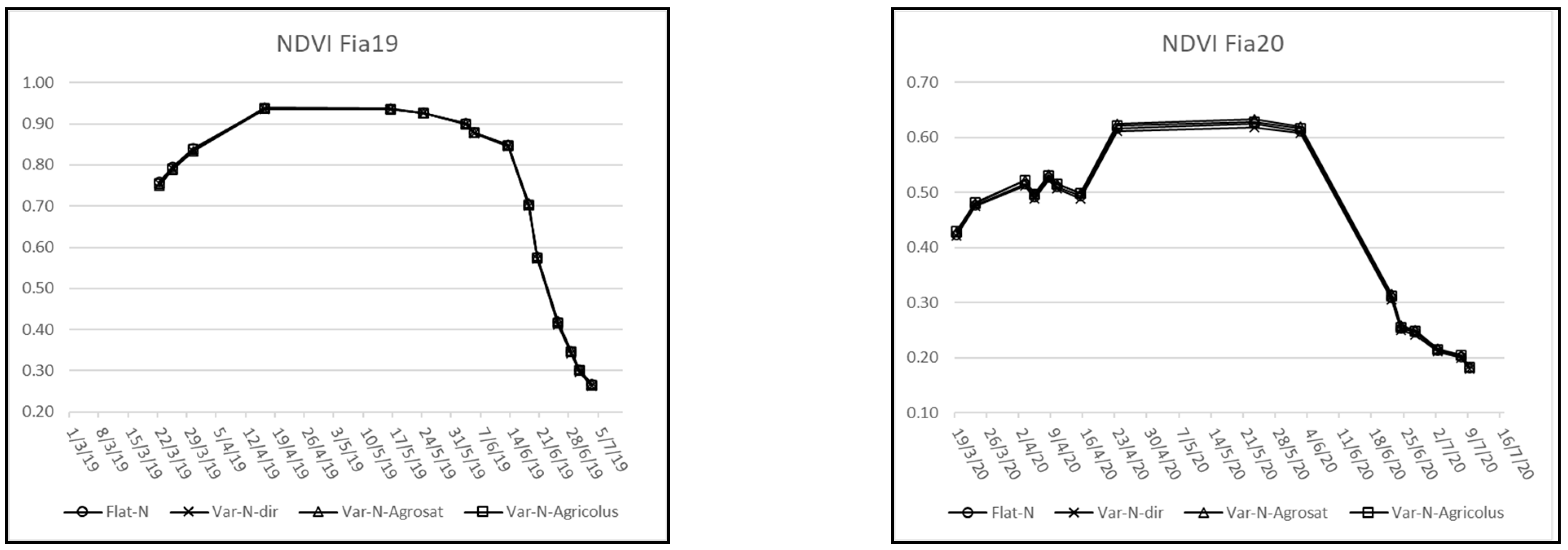
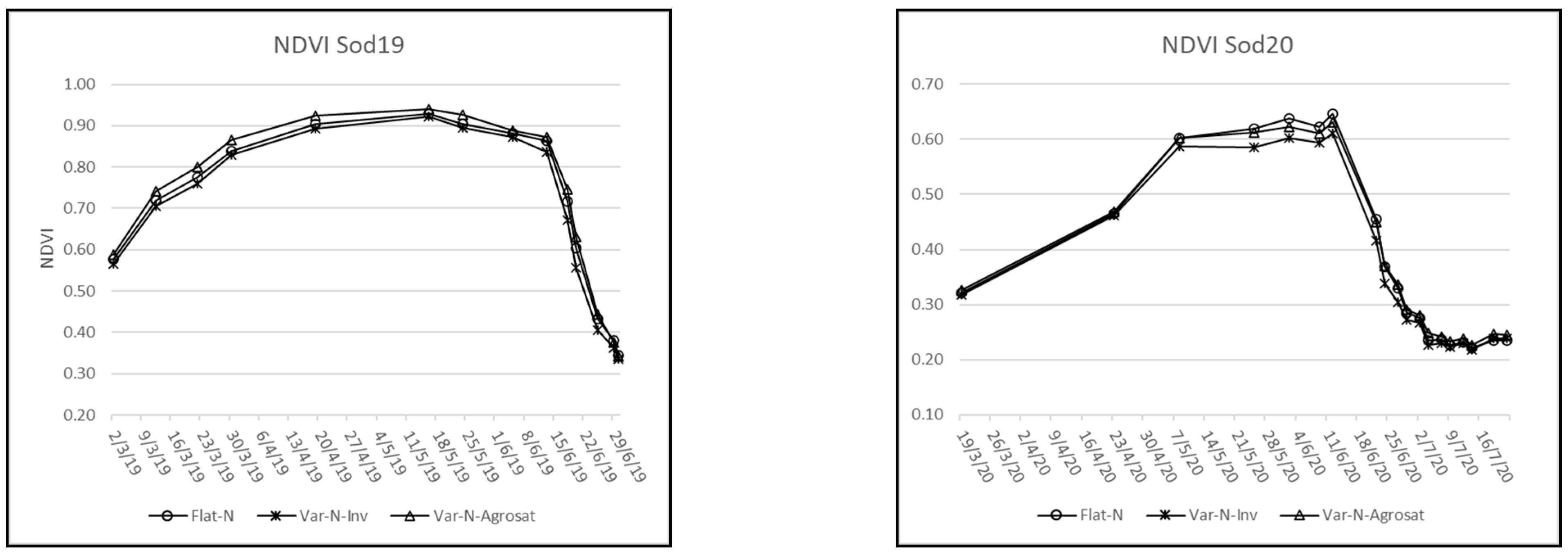
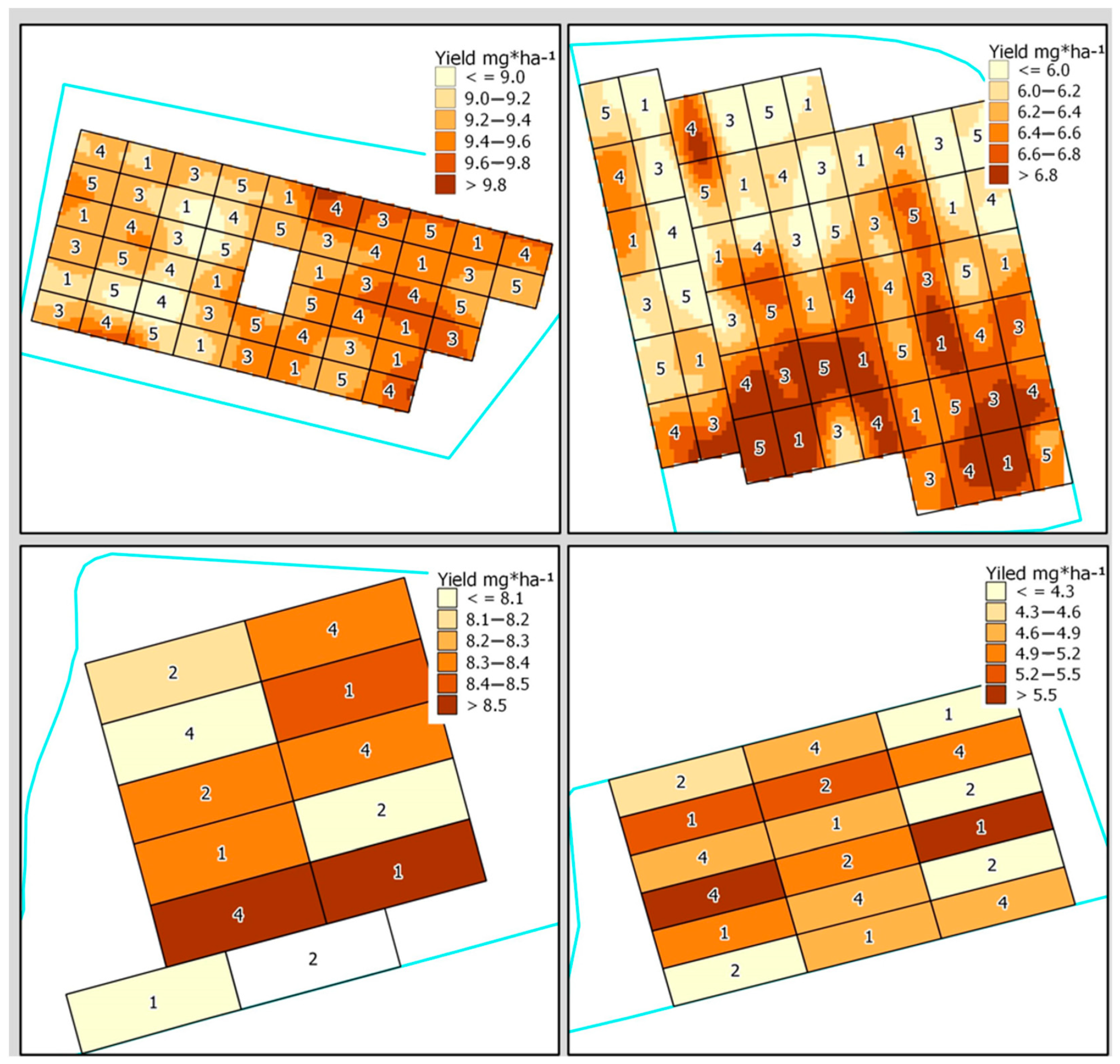
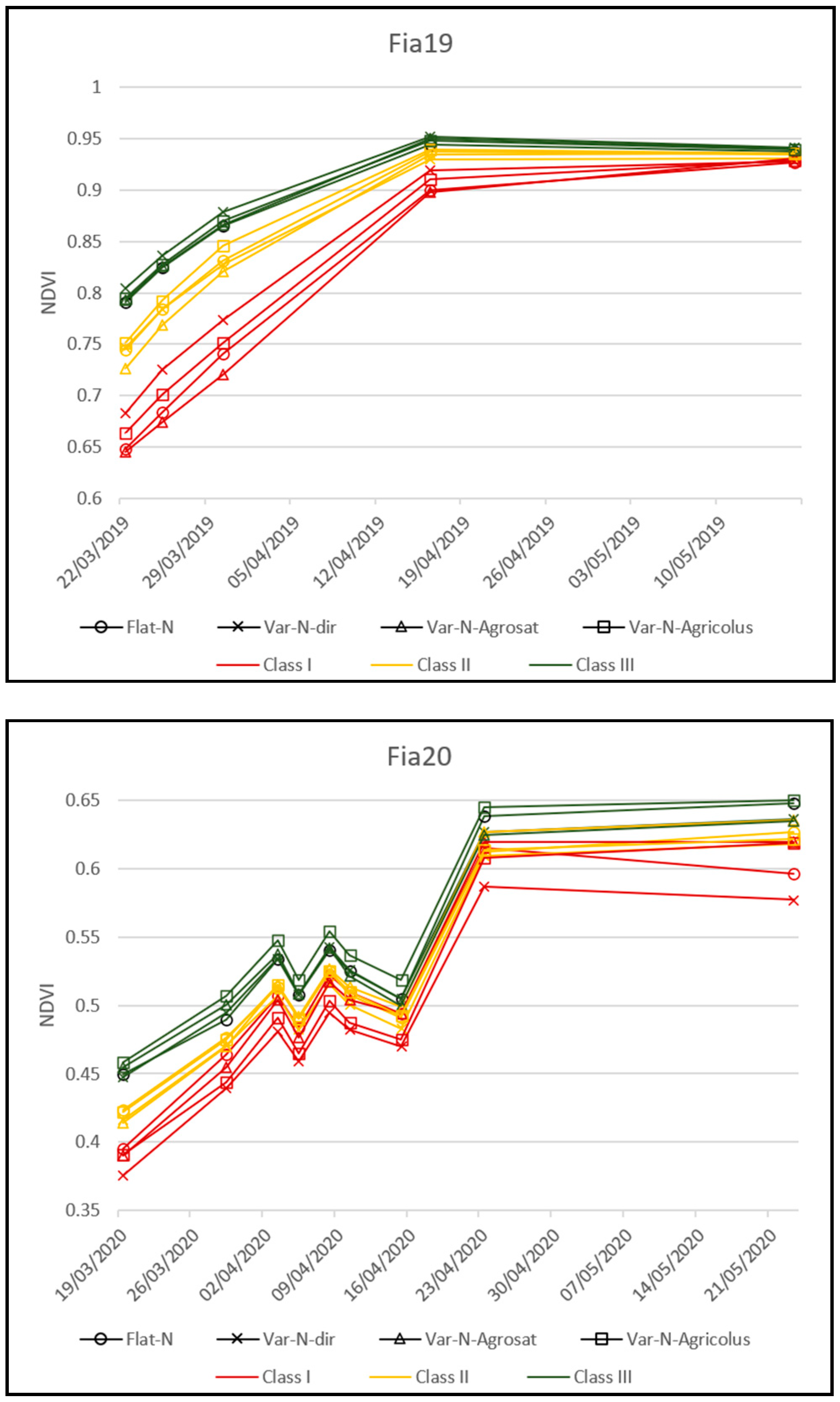
| Field | Fia19 | Fia20 | Sod19 | Sod20 |
|---|---|---|---|---|
| Location | Deruta (PG), Italy | Deruta (PG), Italy | Mugnano (PG), Italy | Mugnano (PG), Italy |
| Coordinates (WGS84) | 42°95′37″ N, 12°38′91″ E | 42°93′54″ N, 12°38′85″ E | 43°04′57″ N, 12°21′74″ E | 43°04′38″ N, 12°21′77″ E |
| Altimetry | 160 m ASL | 158 m ASL | 227 m ASL | 227 m ASL |
| Extent (ha) | 20 ha | 20 ha | 10 ha | 9 ha |
| Previous Crop | Maize (Zea mais L.) | Maize (Zea mais L.) | Sunflower (Helianthus annuus L.) | Maize (Zea mais L.) |
| Variety | PR22R58 | Oregrain | Rebelde | Bandera |
| Sowing Date | 12 November 2018 | 6 December 2019 | 16 November 2018 | 7 January 2018 |
| Second N Application Date | 25 March 2019 | 24 March 2020 | 18 March 2019 | 7 April 2020 |
| Variety | PR22R58 [50] | Oregrain [51] | Rebelde [52] | Bandera [53,54] |
|---|---|---|---|---|
| Classification | Bread wheat | Bread wheat | Strength wheat | Bread wheat |
| Ripening Cycle | Medium–late | Late | Medium | Early |
| Quantitative Yield | Very high | High | High | High |
| Etholithic Weight | Medium | Medium | High | High |
| Grain Protein Content | Medium | Medium–high | Very high | Medium |
| Field | Stats | Moisture % | Sand g/Kg | Silt g/Kg | Clay g/Kg | OM g/Kg | N tot g/Kg |
|---|---|---|---|---|---|---|---|
| Fia19 | avg | 19.4% | 16.7 | 51.4 | 31.9 | 1.82 | 1.25 |
| st.dev. | 1.38% | 7.68 | 4.07 | 6.15 | 0.228 | 0.156 | |
| min | 14.4% | 5.3 | 39.2 | 24.6 | 1.41 | 0.95 | |
| max | 22.0% | 35.0 | 61.4 | 46.0 | 2.32 | 1.60 | |
| range | 7.6% | 29.7 | 22.2 | 21.4 | 0.91 | 0.65 | |
| Fia20 | avg | 19.8% | 27.1 | 46.1 | 26.8 | 1.46 | 0.99 |
| st.dev. | 0.93% | 8.91 | 6.22 | 4.37 | 0.203 | 0.088 | |
| min | 18.5% | 10.8 | 33.2 | 20.3 | 1.10 | 0.80 | |
| max | 21.8% | 46.0 | 57.1 | 35.0 | 2.19 | 1.20 | |
| range | 3.2% | 35.2 | 23.9 | 14.7 | 1.09 | 0.40 |
| Treatment | Description | Fields |
|---|---|---|
| Flat-N | Standard rate calculated by a typical N balance | Fia, Sod |
| Var-N-dir | Variable rate calculated using a simplified linear model, adopting a proportional strategy (NDVI directly related). The maximum rate was equal to the Flat-N rate. | Fia |
| Var-N-inv | Variable rate calculated using a simplified linear model, adopting a compensative strategy (NDVI inversely related). The maximum rate was equal to the Flat-N rate. | Sod |
| Var-N-Agrosat | Variable rate calculated using the AgroSat model based on a compensative strategy (NDVI inversely related). The average rate was equal to the Flat-N rate | Fia, Sod |
| Var-N-Agricolus | Variable rate calculated applying the Agricolus model | Fia |
| Kg N ha−1 | Fia19 | Fia20 | ||||||
|---|---|---|---|---|---|---|---|---|
| Flat-N | Var-N- dir | Var-N- Agrosat | Var-N- Agricolus | Flat-N | Var-N- dir | Var-N- Agrosat | Var-N- Agricolus | |
| Avg | 120.0 | 95.2 | 117.8 | 107.2 | 110.0 | 76.6 | 110.1 | 84.3 |
| Min | 120.0 | 80.0 | 100.0 | 80.0 | 110.0 | 50.0 | 87.4 | 80.7 |
| Max | 120.0 | 120.0 | 134.0 | 118.0 | 110.0 | 104.9 | 124.4 | 87.3 |
| St. Dev. | 0.0 | 12.5 | 12.1 | 9.9 | 0.0 | 17.7 | 11.8 | 2.0 |
| Kg N ha−1 | Sod19 | Sod20 | ||||||
| Flat-N | Var-N- Agrosat | Var-N- inv | Flat-N | Var-N- Agrosat | Var-N- inv | |||
| Avg | 99.8 | 101.6 | 78.5 | 90.0 | 90.0 | 61.4 | ||
| Min | 99.8 | 88.3 | 50.0 | 90.0 | 80.4 | 40.0 | ||
| Max | 99.8 | 114.1 | 100.0 | 90.0 | 107.0 | 85.1 | ||
| St. Dev. | 0.0 | 7.5 | 13.2 | 0.0 | 8.2 | 13.7 | ||
| Field | Treatment | Average N Rate (Kg ha−1) | St. Dev. N Rate (Kg ha−1) | Average Yield (Mg ha−1) | St. Dev. Yield (Mg ha−1) | Average Protein Content (%) | St. Dev. Protein Content (%) | NUE Yield (Kg Yield/Kg N Rate) |
|---|---|---|---|---|---|---|---|---|
| Fia19 | Flat-N | 120 | 0 | 9.45 | 0.19 | 12.29 | 0.47 | 79.38 b |
| Var-N-dir | 95.2 | 12.5 | 9.52 | 0.19 | 12.01 | 0.50 | 96.16 a | |
| Var-N-Agrosat | 117.8 | 12.1 | 9.43 | 0.25 | 12.26 | 0.36 | 80.70 b | |
| Var-N-Agricolus | 107.2 | 9.9 | 9.42 | 0.18 | 12.15 | 0.56 | 86.67 b | |
| Fia20 | Flat-N | 110 | 0.0 | 6.35 | 0.42 | 10.94 | 0.54 | 58.19 c |
| Var-N-dir | 76.6 | 17.7 | 6.21 | 0.44 | 10.62 | 0.58 | 81.56 a | |
| Var-N-Agrosat | 110.1 | 11.8 | 6.44 | 0.37 | 10.90 | 0.44 | 58.88 c | |
| Var-N-Agricolus | 84.3 | 2 | 6.27 | 0.38 | 10.72 | 0.54 | 75.11 b | |
| Sod19 | Flat-N | 100 | 0 | 8.41 | 0.29 | 13.88 | 0.42 | 84.2 b |
| Var-N-inv | 76.7 | 6.4 | 8.18 | 0.16 | 13.52 | 1 | 103.50 a | |
| Var-N-Agrosat | 101 | 7.7 | 8.33 | 0.21 | 14.18 | 0.46 | 82.54 b | |
| Sod20 | Flat-N | 90 | 0 | 4.93 | 0.41 | 12.66 | 0.74 | 54.79 b |
| Var-N-inv | 61.4 | 13.2 | 4.55 | 0.54 | 12.5 | 0.88 | 77.40 a | |
| Var-N-Agrosat | 90 | 8.5 | 4.91 | 0.43 | 12.9 | 0.31 | 54.99 b |
| Treatment | Class | Fia19 | Fia20 | ||
|---|---|---|---|---|---|
| KgN ha−1 | Yield Mg ha−1 | KgN ha−1 | Yield Mg ha−1 | ||
| Flat-N | I | 122 | 9.5 | 111 | 6.2 |
| II | 117 | 9.5 | 110 | 6.4 | |
| III | 118 | 9.4 | 110 | 6.4 | |
| Var-N-dir | I | 85 | 9.7 | 50 | 5.8 |
| II | 95 | 9.5 | 71 | 6.2 | |
| III | 110 | 9.5 | 97 | 6.4 | |
| Var-N-Agrosat | I | 130 | 9.3 | 124 | 6.4 |
| II | 122 | 9.5 | 114 | 6.5 | |
| III | 110 | 9.4 | 101 | 6.3 | |
| Var-N-Agricolus | I | 97 | 9.5 | 87 | 6.6 |
| II | 115 | 9.2 | 85 | 6.2 | |
| III | 110 | 9.4 | 82 | 6.5 | |
| Fia19 | Grain Protein Content | Grain Yield | Soil Clay Content | Soil OM Content | Soil Total N Content |
|---|---|---|---|---|---|
| Grain Yield | −0.37 ** | ||||
| Soil Clay Content | 0.36 ** | −0.56 *** | |||
| Soil OM Content | 0.48 *** | −0.51 *** | 0.90 *** | ||
| Soil Total N Content | 0.47 *** | −0.49 *** | 0.92 *** | 0.98 *** | |
| NDVI March 22 | 0.50 *** | −0.25 . | 0.49 *** | 0.65 *** | 0.68 *** |
| NDVI March 25 | 0.53 *** | −0.28 * | 0.55 *** | 0.69 *** | 0.73 *** |
| NDVI March 30 | 0.54 *** | −0.30 * | 0.54 *** | 0.68 *** | 0.72 *** |
| NDVI April 16 | 0.37 ** | 0.02 | −0.02 | 0.11 | 0.20 |
| NDVI May 16 | 0.26 | 0.06 | −0.18 | −0.07 | 0.03 |
| NDVI May 24 | 0.38 ** | −0.04 | 0.04 | 0.13 | 0.22 |
| NDVI June 3 | 0.44 ** | −0.04 | 0.05 | 0.18 | 0.26 . |
| NDVI June 5 | 0.27 . | 0.12 | −0.23 | −0.10 | 0.00 |
| NDVI June 13 | 0.23 | 0.24 . | −0.45 *** | −0.25 . | −0.22 |
| NDVI June 18 | 0.05 | 0.35 * | −0.68 *** | −0.53 *** | −0.50 *** |
| NDVI June 20 | −0.01 | 0.36 ** | −0.74 *** | −0.59 *** | −0.58 *** |
| NDVI June 25 | 0.18 | 0.17 | −0.52 *** | −0.38 ** | −0.33 * |
| NDVI June 28 | 0.18 | 0.15 | −0.49 *** | −0.35 * | −0.29 * |
| NDVI June 30 | 0.23 | 0.10 | −0.38 ** | −0.28 * | −0.20 |
| NDVI July 3 | 0.22 | 0.09 | −0.38 ** | −0.27 . | −0.19 |
| Sod19 | Grain Protein Content | Grain Yield |
|---|---|---|
| Grain Yield | 0.30 | |
| NDVI March 2 | 0.17 | 0.25 |
| NDVI March 5 | 0.56 . | 0.44 |
| NDVI March 12 | 0.39 | 0.35 |
| NDVI March 22 | 0.56 . | 0.47 |
| NDVI March 30 | 0.66 * | 0.30 |
| NDVI April 19 | 0.66 * | 0.31 |
| NDVI May 16 | 0.51 | 0.24 |
| NDVI May 24 | 0.12 | 0.43 |
| NDVI June 5 | 0.72 * | 0.13 |
| NDVI June 13 | 0.75 ** | 0.30 |
| NDVI June 18 | 0.81 ** | 0.14 |
| NDVI June 20 | 0.78 ** | 0.09 |
| NDVI June 25 | 0.68 * | −0.07 |
| NDVI June 28 | 0.48 | −0.18 |
| NDVI June 30 | 0.52 | −0.19 |
| NDVI July 3 | 0.24 | −0.32 |
| NDVI July 5 | 0.31 | −0.29 |
| Fia20 | Grain Protein Content | Grain Yield | Soil Clay Content | Soil OM Content | Soil Total N Content |
|---|---|---|---|---|---|
| Grain Yield | 0.47 *** | ||||
| Soil Clay Content | 0.02 | −0.13 | |||
| Soil OM Content | −0.08 | −0.32 * | 0.46 *** | ||
| Soil Total N Content | −0.11 | −0.26 * | 0.72 *** | 0.85 *** | |
| NDVI March 19 | 0.29 * | 0.17 | −0.34 ** | −0.21 | −0.41 ** |
| NDVI March 9 | 0.22 . | 0.10 | −0.13 | −0.03 | −0.17 |
| NDVI April 3 | 0.32 * | 0.13 | 0.14 | 0.14 | 0.06 |
| NDVI April 5 | 0.31 * | 0.21 | 0.09 | 0.08 | 0.00 |
| NDVI April 8 | 0.32 * | 0.17 | 0.31 * | 0.25 . | 0.23 . |
| NDVI April 10 | 0.29 * | 0.24 . | 0.37 ** | 0.25 . | 0.26 * |
| NDVI April 15 | 0.30 * | 0.31 * | 0.52 *** | 0.35 ** | 0.42 *** |
| NDVI April 23 | 0.43 *** | 0.57 *** | 0.43 *** | 0.20 | 0.27 * |
| NDVI May 23 | 0.54 *** | 0.80 *** | −0.06 | −0.25 . | −0.29 * |
| NDVI May 25 | 0.47 *** | 0.79 *** | −0.03 | −0.28 * | −0.28 * |
| NDVI June 2 | 0.42 *** | 0.83 *** | −0.14 | −0.35 ** | −0.36 ** |
| NDVI June 22 | 0.45 *** | 0.60 *** | 0.46 *** | 0.06 | 0.23 . |
| Sod20 | Grain Protein Content | Grain Yield |
|---|---|---|
| Grain Yield | −0.05 | |
| NDVI March 19 | −0.37 | 0.25 |
| NDVI April 23 | −0.24 | 0.15 |
| NDVI May 8 | −0.41 . | 0.30 |
| NDVI May 25 | −0.34 | 0.39 |
| NDVI June 2 | −0.21 | 0.29 |
| NDVI June 9 | 0.15 | 0.16 |
| NDVI June 12 | 0.27 | 0.13 |
| NDVI June 22 | 0.34 | 0.00 |
Publisher’s Note: MDPI stays neutral with regard to jurisdictional claims in published maps and institutional affiliations. |
© 2021 by the authors. Licensee MDPI, Basel, Switzerland. This article is an open access article distributed under the terms and conditions of the Creative Commons Attribution (CC BY) license (https://creativecommons.org/licenses/by/4.0/).
Share and Cite
Santaga, F.S.; Benincasa, P.; Toscano, P.; Antognelli, S.; Ranieri, E.; Vizzari, M. Simplified and Advanced Sentinel-2-Based Precision Nitrogen Management of Wheat. Agronomy 2021, 11, 1156. https://doi.org/10.3390/agronomy11061156
Santaga FS, Benincasa P, Toscano P, Antognelli S, Ranieri E, Vizzari M. Simplified and Advanced Sentinel-2-Based Precision Nitrogen Management of Wheat. Agronomy. 2021; 11(6):1156. https://doi.org/10.3390/agronomy11061156
Chicago/Turabian StyleSantaga, Francesco Saverio, Paolo Benincasa, Piero Toscano, Sara Antognelli, Emanuele Ranieri, and Marco Vizzari. 2021. "Simplified and Advanced Sentinel-2-Based Precision Nitrogen Management of Wheat" Agronomy 11, no. 6: 1156. https://doi.org/10.3390/agronomy11061156
APA StyleSantaga, F. S., Benincasa, P., Toscano, P., Antognelli, S., Ranieri, E., & Vizzari, M. (2021). Simplified and Advanced Sentinel-2-Based Precision Nitrogen Management of Wheat. Agronomy, 11(6), 1156. https://doi.org/10.3390/agronomy11061156








